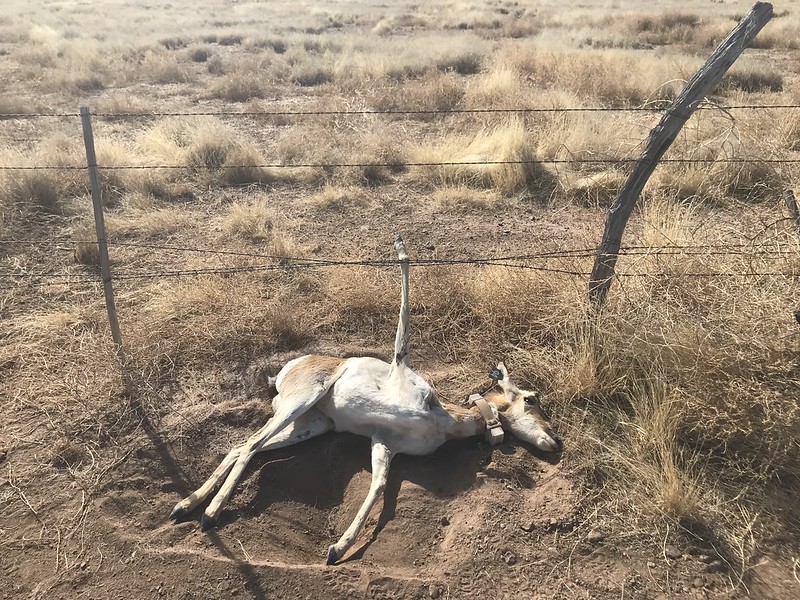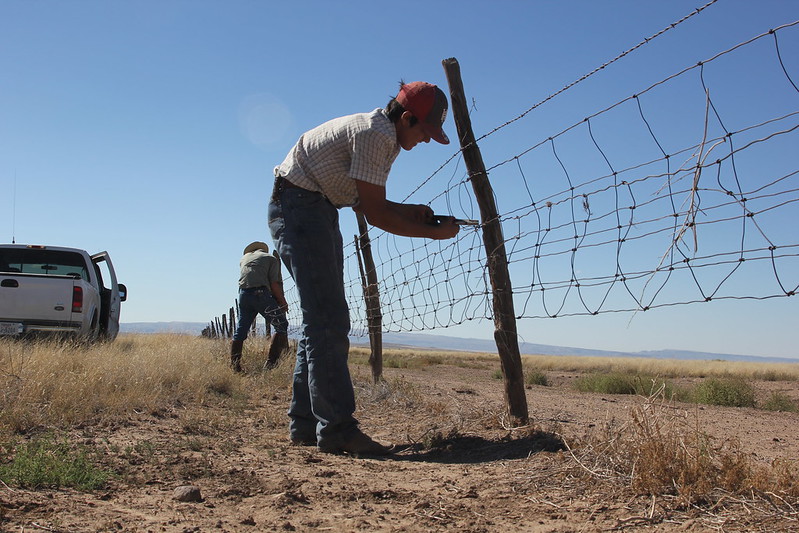Editor’s note: one of the worst environmental disasters that nearly no-one has heard of is “habitat fragmentation.” Many ecologists believe that habitat fragmentation is the single most serious threat to biological diversity and is the primary cause of the present extinction crisis.
Fences, roads, utility corridors, and other linear human disturbances increasingly shatter habitats into smaller and smaller pieces, with drastic consequences. This crisis is not being addressed, and it gets worse every day. This article explores one part of this problem: the effects of fencing on Pronghorn.
By Tara Lohan
With the arrival of spring each year, pronghorn that winter in the Upper Green River Valley of Wyoming begin a journey of more than 100 miles to their summer habitat near Grand Teton National Park.
It’s one of the longest migrations of large mammals remaining in North America. But their trek — and a similar one made by mule deer — is made more difficult by human developments along the way, particularly fences.
“The total length of fencing around the world may now exceed that of roads by an order of magnitude, and continues to grow due to a global trend towards land partition and privatization,” wrote researchers of new U.C. Berkeley-led study published in the Journal of Applied Ecology.
Wyoming is no exception. There the researchers found nearly 3,800 miles of fences in their study area alone — twice the length of the U.S.-Mexico border. Their research tracked GPS-collared pronghorn (Antilocapra americana) and mule deer (Odocoileus hemionus) during two years of their migrations to better understand how fences affect the animals’ movements and which kinds of fences may be most difficult.
Fences aren’t always bad for wildlife — some can keep animals off roads, for instance — but they can also pose threats. [Editor’s note: to use precise language, these fences aren’t “good” for wildlife; they partially mitigate some of the harms of roads]
For animals like pronghorn and mule deer, fences can halt or change migration routes. Animals that attempt to go over or under also risk becoming entangled and perishing. Juveniles are particularly at risk. A 2005 Utah State University study of ungulate migration across Colorado and Utah found the youngsters died in fences 8 times more often than adults. Many others died of starvation or predation when they weren’t able to cross fences and were separated from their mothers.

Most of the fences the animals encounter run along the edges of livestock pastures, private property lines or roads, and are composed of four or five strands of barbed wire. Some have woven wire at the bottom, the most common type of fence for corralling sheep but also the most lethal to wildlife.
“A better understanding of wildlife responses to fencing is … critical to conservation,” the researchers of the U.C. Berkeley study wrote.
But here’s what we do know: The study found that both pronghorn and mule deer “were extensively affected by fences.”
Each year an average mule deer encountered fences 119 times and pronghorn 248 times. In about 40% of those encounters, the fence changed the animal’s behavior. And that behavior, they found, was more complex than simply crossing or not crossing the fence.
Often the animals “bounced,” or rapidly moved away from the fence when they couldn’t quickly cross. “Such avoidance of fences can drive animals away from high‐quality resources and reduce habitat use effectiveness,” they wrote.
Other times the animals paced back and forth along the fence line, a behavior that could strain energy resources. And occasionally they became trapped in areas with a high concentration of fences, like livestock pastures.
This can create other problems.
“Constraining animal movements for prolonged periods within limited areas may trigger human–wildlife conflicts,” the researchers found. Pronghorn, for example, have been seen in new developments in Colorado Springs, where they’ve been hit by cars and shown up at the airport.
Mule deer and pronghorn also behave differently when encountering fences. Mule deer are more likely to jump a fence, and pronghorn to crawl under.
“The reluctance to jump means that pronghorn movements can be completely blocked by woven‐wire sheep or barbed‐wire fences with low bottom wires — the two most common types of fences across their home range in North America,” the researchers found.
Considering that the American West may have upwards of 620,000 miles of roadside and pasture fences, “fence modifications for conservation might be more urgent than currently recognized,” they wrote.
Efforts are underway to encourage or require more “wildlife-friendly” fences that “are very visible and allow wild animals to easily jump over or slip under the wires or rails,” according to recommendations from Colorado’s Parks and Wildlife agency.
Further guidance from Sustainable Development Code, an organization that works on sustainability issues with local governments, recommends using smooth, instead of barbed wires; limiting the height of fences 42 inches; allowing 16 inches of clearance at the bottom; and including wide spacing between wires.

“There are other forms of wildlife-friendly fencing, including ‘lay-down’ or temporary fences that permit wildlife crossing during critical migratory seasons,” the group reports.
Making fence lines more visible is also helpful to other animals, including birds. Low-flying birds, like grouse, also die in fences across the West’s rangelands.
That’s why wildlife managers are beginning to push for removing or modifying fences, but the effort can be costly. To address this concern, the researchers developed a software package, available to wildlife managers and other researchers, that highlights fences posing the biggest threats to animal movement. They hope it will help make the best use of limited conservation funds and help protect critical migration pathways.
“We demonstrate that when summed and mapped, these behaviors can aid in identifying problematic fence segments,” they wrote. And that could help save a lot of pronghorn, mule deer and other animals.
Ths story first appeared at The Revelator. Banner image: Pronghorn encounter a fence line in New Mexico. Photo: Johnida Dockens (CC BY-NC-ND 2.0)


Closing roads in wildlife areas was a big issue in Earth First! when I was a campaigner for them in the 1980s. It’s no secret among wildlife biologists or ecologists that roads, fences, and other unnatural human obstructions fragment habitat and greatly harm wildlife. The problem, as usual, is that people prioritize everything over other species. Road for killing trees (aka, “logging”), fences for damn cattle, and other human harms are allowed because the vast majority of people don’t care enough about other species, or about the, land, air, water, or sky. As I’ve said all along, this is a battle for the hearts & minds of people, and if we don’t win that, we lose, “we” meaning the Earth and all life on it.
Another perverse issue with roads and fences is that we would be hard pressed to design a more lethal trap for wildlife. In dry Australia, road verges are always very green because of water runoff from the impervious tar road, and often with young shoots from the councils maintaining them. So herbivorous kangaroos, wallabies and possums concentrate on them at night, being nocturnal. One ton lumps of metals screeching by at high speed with bright and disorienting headlights make the perfect cocktail for disaster and very often results in collisions. 18000 accidents are reported every year, but for the wildlife the toll is staggering. And of course predators like quolls and tasmanian devils prey on the omnipresent carcasses on the road and add to the toll.